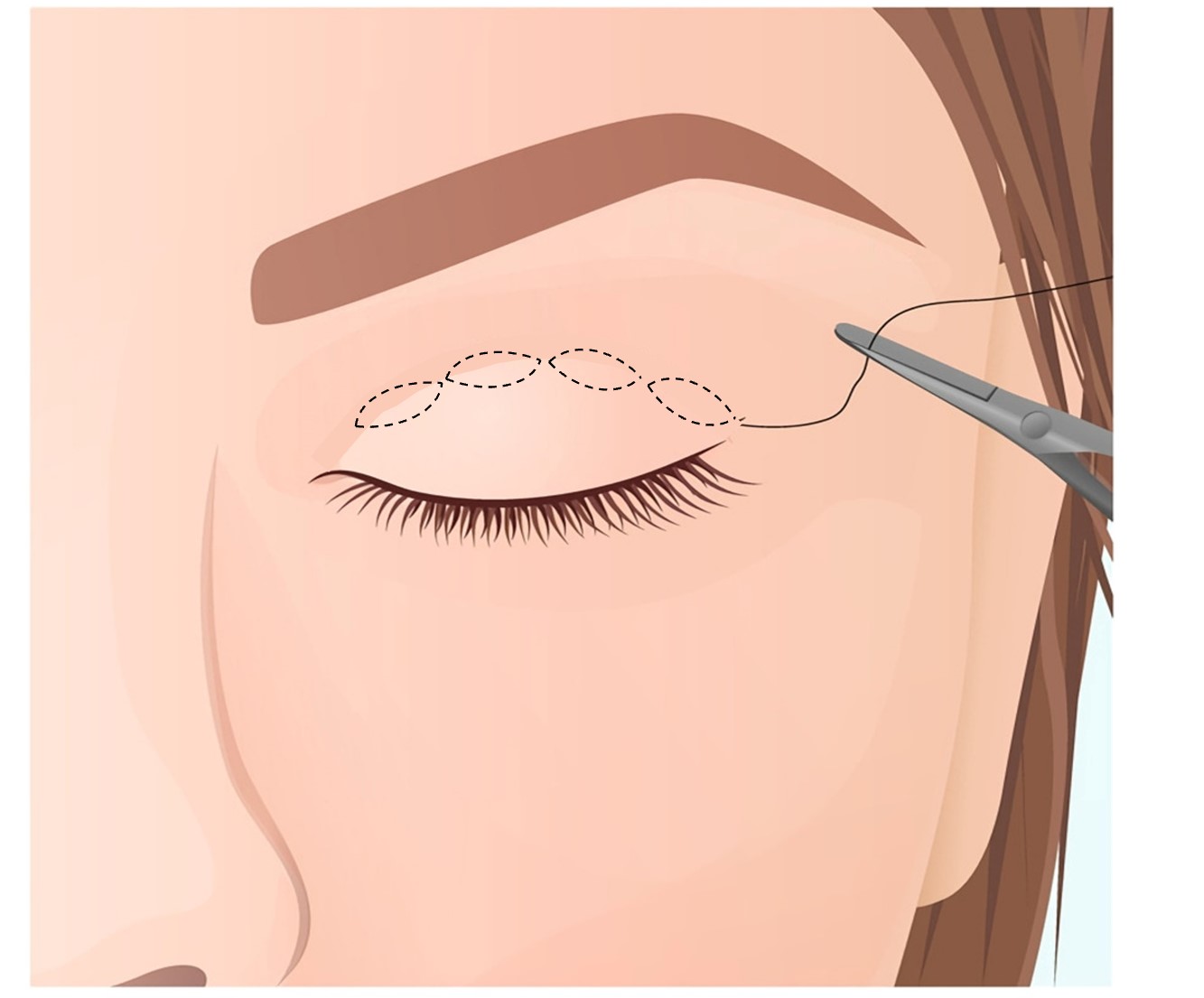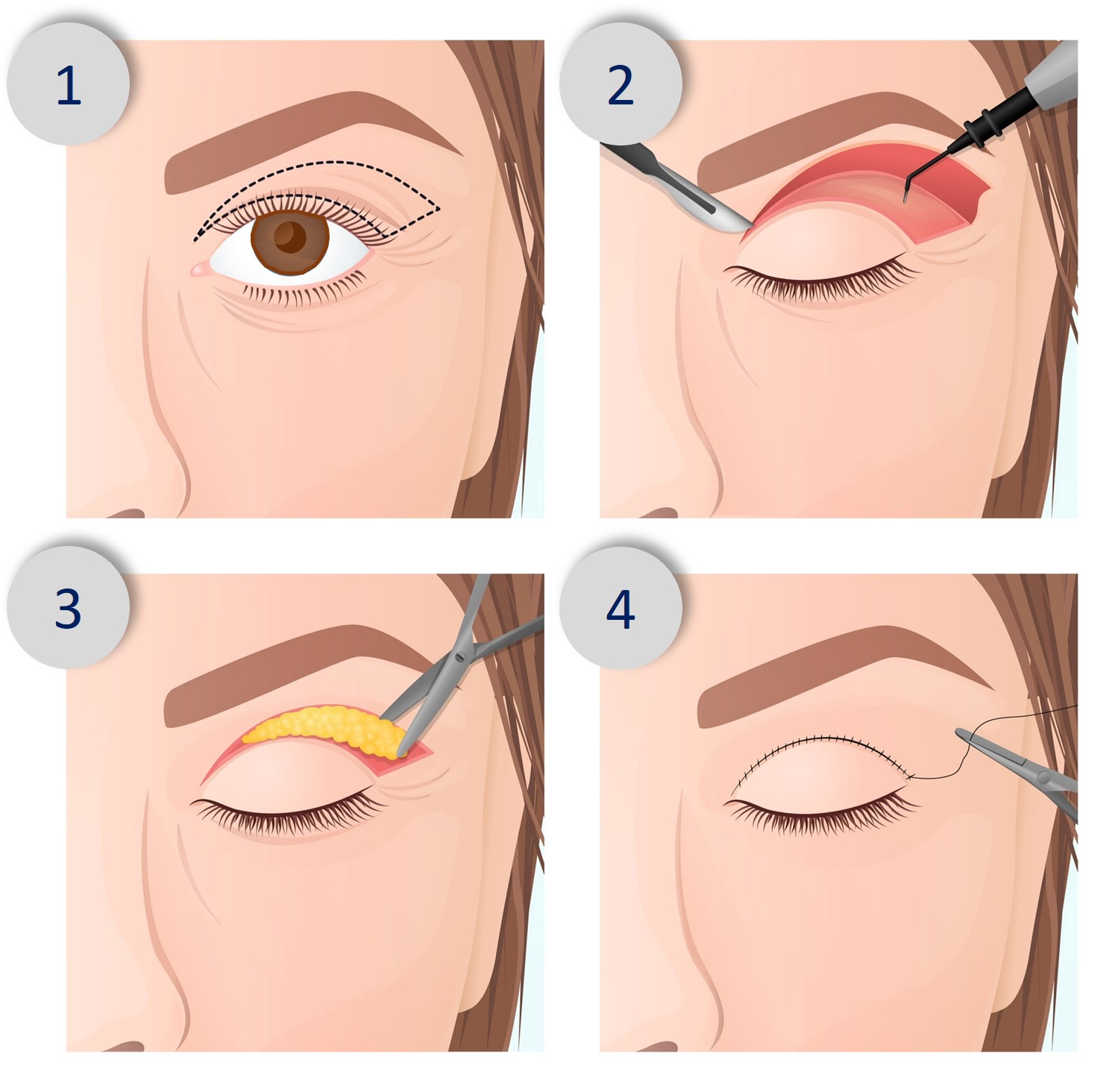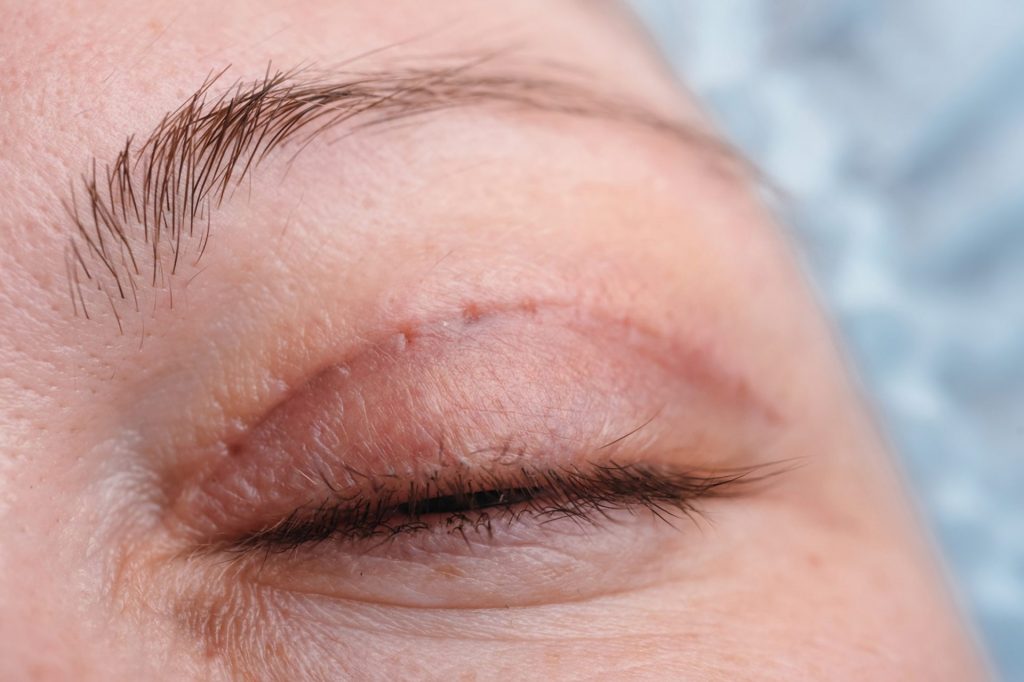
Lines that define. Brighter looking eyes with natural eyelids.

Procedure Time
20 – 60 Minutes

Anaesthesia
Local Anaesthesia or Sedation

Recovery Period
5 – 7 Days

Stitch Removal
Not Required or
7 Days Post-op
What Is Double Eyelid Surgery in Singapore?
Double eyelid surgery, also known as blepharoplasty, is a cosmetic procedure in which the skin around the eye is reshaped in a way to create a crease in the upper eyelid. Typically, this procedure involves incisions or punctures made to the skin.
Double eyelid surgery in Singapore is one of the most well-known aesthetic procedures. The procedure is popular in the country and is expected because approximately 50% of East and Southeastern Asian women are born with either a minimal or absent upper eyelid.
Types of Double Eyelid Surgery
Generally, there are two types of double eyelid surgery techniques available:
Non-Incisional Blepharoplasty Double Eyelid Surgery

Non-incisional or suture blepharoplasty is popularly known as a scarless or stitching method as it involves stitching of the eyelid.
Four small holes are created through which sutures are weaved and knotted in the upper eyelid. This stitching creates an approximation between the eyelid skin and the underlying deep tissue and helps to produce the crease without any scar marks.
Incisional Blepharoplasty Double Eyelid Surgery

Incisional double eyelid surgery is performed if a well-defined crease line is preferred, also if there are signs of droopy eyelids. In this surgical procedure, an incision is made over the upper eyelid, and the extensively overstretched and lengthened eye muscle is trimmed off.
These muscles are later pinned upwards and then sutured in place. The results produced are tightening of the muscles, elimination of excess skin and fat, and redefined upper eyelids, which lift higher when opened.
Suitable Candidates
The procedure is best suitable for those who have any of the following:
Single Eyelid
Double Eyelid On One Eye
Shallow Double Eyelid
Multiple Eyelid Crease
Asymmetrical Eyelid
Droopy Eyelids
- Single eyelid (absence of palpebral crease)
- Only one eye has a double eyelid
- The creases are shallow and are not very much apparent
- Multiple creases are present on each eyelid
- The eyelid creases are not symmetrical
Comparison of Double Eyelid Surgery in Singapore
Here is a quick glance at the differences and benefits of Dream Singapore’s non-incisional and incisional double eyelid surgery methods.
Signature Dual Burial Method
Surgical Method: Double spiral knot
Procedure time: 20 minutes
Anesthesia: Local anesthesia or light sedation
Recovery period: 3 – 5 days
Stitch removal: Not required
Results: Semi-permanent, natural crease line
Incisional Method
Surgical Method: Micro incisions and knots
Procedure time: 30 – 60 minutes
Anesthesia: Light sedation
Recovery period: 5 – 7 days
Stitch Removal: 7 days after procedure
Results: Permanent, well defined crease line
Recovery from Double Eyelid Surgery

The non-incisional method of double eyelid surgery is characterised by a fast recovery. It takes only 7 to 10 days for recovery, and there are minimal to no visible scar marks left in the end.
In the case of incisional blepharoplasty, the swelling will significantly subside in a week or two. However, it may take up to 6 weeks for the full results to be achieved. Meanwhile, you have to abide by the aftercare guidelines. A linear scar of the incision may be left in the end but it will fade away with time.
Post Double Eyelid Surgery Care Tips
Post-surgical care is important for healing and optimal recovery. Here’s how you should take care of your eyelids following blepharoplasty to ensure the best outcome.
- Wear a hat or sunglasses and use sunscreen when you are outdoors. This protection is necessary to prevent the UV rays from damaging the area, increasing swelling, and slowing the healing process.
- Avoid activities that increase pressure in your eyes, such as lifting heavy objects and doing strenuous exercise.
- Do cold compressing of the eyelids. It helps reduce the swelling and discomfort significantly.
- Avoid smiling or yawning excessively. This can cause stitches to open by applying unnecessary strain on the eyelid muscles.
- Keep your head elevated while sleeping. Maintaining an upright position is also important. You can use extra pillows to keep the head elevated and to maintain the proper position.
- If you experience pain, take OTC painkiller drugs such as Tylenol or any other prescription medication. Avoid taking aspirin, Aleve, or Motrin to reduce the chances of bleeding and post-surgical hematoma formation.
Risks and Complications
Double eyelid surgery, or blepharoplasty, is generally a very safe procedure. However, like any other cosmetic surgery, it does carry some risks of side effects, complications, and undesirable results. These include;
- Bleeding
- Infection of the wound site
- Visual problems
- Asymmetry of the creases of two eyelids
- Sunken upper eyelids
- Loss of levator muscle strength due to injury
If the surgery is performed by a skilled surgeon, and you take proper aftercare, the likelihood of experiencing complications is significantly reduced.
Contact Our Singapore Clinic To Learn More About Double Eyelid Surgery Using Suture Or Incisional Technique
Learn more about droopy eyelid surgery in Singapore? Contact us at +65 6871 8888 or send us a message through our enquiry form to get in touch. Our medical team will guide you through every step of the process, from booking an appointment for consultation to answering any questions you may have.
Frequently Asked Questions (FAQ) about Double Eyelid Surgery
Is Double Eyelid Surgery A Painful Procedure?
Pain is the most frequent concern of people undergoing surgery. As mentioned earlier, double eyelid surgery is performed under sedation. You will not feel any discomfort during surgery. Moreover, your doctor will prescribe painkillers to deal with post-surgery pain.
How Long Do The Results Last After Undergoing Double Eyelid Surgery?
The results of incisional blepharoplasty are permanent. On the other hand, the results of non-incisional blepharoplasty are semi-permanent, and their longevity depends upon the success of the surgery and proper aftercare. The longevity of the results depends on individual eyelid aging, eyelid muscle, and skin elasticity over time.
How To Find The Best Surgeon For My Double Eyelid Surgery In Singapore?
It is crucial to find an experience surgeon for your double eyelid surgery in Singapore. Here are a few tips to find one;
- Try to get a referral of a good cosmetic surgeon from your family doctor.
- Ask from those who have undergone this surgery.
- Ask the surgeon about his years of practice and the number of double eyelid surgeries they have done.
- Assess the expertise of the surgeon by looking at the before and after pictures of their patients.
If I’ve done double eyelid surgery before, would a repeat procedure be harmful to my eyelids?
The result of cutting blepharoplasty is permanent, whereas the outcome for a non-incisional procedure is temporary or semi-permanent (because it can last up to 10 years).
As you age, your eyelid muscle loses its strength, and your skin its elasticity. So if you have done double eyelid surgery before, it is natural for your double eyelids to change over time. In some cases, a repeat procedure or revision blepharoplasty can help tighten the skin, correct the complications, and rejuvenate the eyelid. Based on physical examination, your surgeon will be able to help you decide whether the repeat procedure will be suitable for you or not.
What to prepare before double eyelid surgery?
You can take several precautionary measures to ensure that the procedure’s outcome is the best possible. You should:
- Stop smoking and consuming alcohol at least four to six weeks before the surgery to build a robust immune system and speed up the recovery time.
- Keep yourself adequately hydrated and regularly apply moisturiser for an optimum outcome.
- Avoid taking homeopathic medicine, aspirin or OTC anti-inflammatory medication, or multivitamins. They can increase the risk of bleeding.
- Avoid wearing makeup, lenses, false eyelashes or any other cosmetic on the surgery day.
- To gain clarity about the procedure, you can ask the surgeon several questions, such as the scars’ visibility, the recommended anesthesia, healing time, and realistic results. This will help you better understand the process before making an informed decision.
How Long Will It Take For Me To Heal And Recover?
The recovery time for the double eyelid surgery process differs greatly and depends on the type of surgery method performed. The two common types of surgical methods are:
Suture double eyelid surgery (stitching method)
The stitching or suture method is the more common option and the recovery time for this process is about 4-7 days. The swelling subsides within a week.
This is the preferred method because the sutures are hidden inside of the eyelid skin. So, you can get back to your normal routine by the end of a week.
Incisional double eyelid surgery (cutting method)
The swelling caused by this surgical procedure takes 7-10 days to subside. However, you shall see a full recovery in about 6 weeks.
How Long Will It Take Before I Look Normal?
The time taken for recovery varies from patient to patient. Some patients heal faster than others.
The healing process is a gradual one and it usually takes 2-3 weeks for the patient to start looking normal. One of the initial post-surgery issues is a high eye crease which decreases as the swelling subsides. However, you shall feel improvements after 2 weeks.
Most patients can expect to see final results 3 months after surgery. Your appearance after 6 months will be way better than your 6-week condition and results are evaluated again a 6 months after your procedure.
What Can I Do To Minimize Swelling Of The Eyelids?
Knowing the fact that swelling is a common complication after surgery, everyone wants to know how to minimize it. You can follow these steps to keep the swelling to a minimum:
- Apply a cooling mask to the surgical site within the first 48 hours (because the swelling is highest on the second day and subsides after that)
- Prevent the use of cosmetics and creams until the suture is removed
- Keep your head above heart level while sleeping to aid in healing
Alternatively, anti-swelling supplements can also be prescribed for recovery management.
